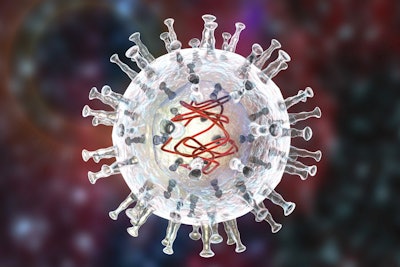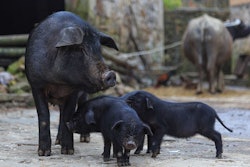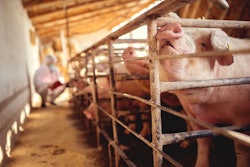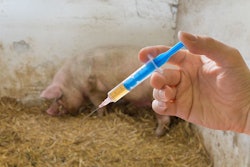
Research microbiologists Douglas Gladue and Manuel Borca from the USDA’s Agricultural Research Service discuss details about some of the vaccine candidates for African swine fever.
PODCAST: USDA researchers optimistic about ASF vaccine candidates (08:44)
Ann Reus: Hello and welcome to the Feed Strategy podcast. I’m your host, Feed Strategy staff reporter Ann Reus.
I’m speaking today with research microbiologists Douglas Gladue and Manuel Borca. They both work for the U.S. Department of Agriculture’s Agricultural Research Service where they study foreign animal diseases including African swine fever. There has been a lot of buzz lately about the promising potential of ASF vaccines, which could be a game changer for the swine industry. So I’ve asked these two scientists here today to share some details about some of the vaccine candidates out there and tell us more about how they work.
Hello Doug and Manuel. It’s great to have you here today.
Gladue/Borca: Hi, thank you.
Reus: So, the big news recently is the USDA’s development of an African swine fever vaccine candidate that does not rely on live pigs and their cells for vaccine production. Can you tell me about the research and development behind this vaccine candidate and how it works?
Gladue: Hi, this is Doug Gladue. I’ll answer that question. So, previously, a lot of the live attenuated vaccines for African swine fever could only be grown in primary swine macrophages, so primary swine macrophages had to be isolated from donor pigs. So, the recently reported vaccine candidate, which we call ASFV-G-ΔI177L/ΔLVR, has an additional deletion in the left variable region. And this deletion, for some reason, allows for growth in pipec cells and pipec cells are Plum Island porcine endothelial cells that were developed in house and are a continuous porcine epithelial cell.
This solves a large hurdle in the commercialization of an ASF vaccine, as relying on primary swine macrophages would be difficult to produce any live attenuated vaccine at any commercial scale. Primary cells also do not allow for the certification of a production cell line, and pipec cells are suitable production cell line for our vaccine candidate that we just reported. This should facilitate their approval by regulatory authorities and allow for an easier production of the vaccine on a commercial scale.
Reus: Do you think this new development gets us any closer to having a commercially available vaccine for ASF?
Gladue: Yes, the continuous cell line, such as pipec cells does allow for the certification for production cell line for vaccine candidates. And this is something that was just not possible when we were using primary swine macrophages.
Reus: Can you provide an update on the trials of a live attenuated vaccine that were being conducted at Plum Island early this year? And can you explain how that vaccine candidate is different from the one we were just discussing?
Borca: Yes, this Manuel Borca. Yeah, what lately we have tested at Plum Island is the 177L vaccine machine, the original version of that vaccine, that in trials in animals trying to use are the oro-nasal route of inoculation. The use of this route is very important in African swine fever, because one of the main concerns in African swine fever is the presence of the virus in wild swine. And the only way to vaccinate those animals, once the vaccine is available, is by using the oro-nasal route, more precisely there oral route. So, testing the ability of any African swine fever vaccine in this case, the I177L candidate, or being administrated by the oro-nasal route is a critical issue in order to think in the possibility of using any vaccine virus in African swine fever, live attenuated vaccine virus in wild animals, which as I said before, is a critical issue in the protection of swine animals — wild animals.
Reus: And is that vaccine candidate the same one that Vietnam’s agriculture minister said would be produced and marketed there this year? And do you think that is a realistic goal, or do you have any insight on where they are with that plan?
Gladue: So, we don’t really know what the Vietnamese government is referring to, which vaccine candidate at this time, but we have been working with a company in Vietnam called NAVETCO, which is going pretty well, we’ve seen reproducibility of our results at Plum Island with them both in domestic pigs and their local pigs, which we’re very happy for and things are going well.
Reus: The Philippines recently reported that it has begun trials of an ASF vaccine, and other trials are going on in various regions. Can you talk about any other promising results that have come out of other countries?
Borca: Unfortunately, there is not enough clear information about what are the characteristics of the vaccines that are being trialed in the field in different countries. So, I will say that, at this point, there is no way, there’s not enough information available in order to have a real educated answer at this point.
Reus: Do you think that more information sharing is needed between the countries that are doing the research?
Borca: What I feel is that, in general, countries are testing vaccines that are – basically, the information that we have is not very clear. It would be great if we have better knowledge about what is being tested and where, but the truth is that that information is not available. But the problem is that we know which laboratories in the world are producing which vaccines they develop based on publications, scientific publications. From that point to what is being tested is a complete lack of information. You can have some idea, base it in some little bit of tips there and here, but it’s not a real understanding. So, for us, it’s impossible to know and to have an opinion, because we don’t know.
Reus: Well lastly, I wanted to ask you both, do you have an estimate on when do you think we might have a widely available vaccine that prevents ASF?
Gladue: I think it’s very hard to predict timelines, and the timelines really depend on what is required in different countries and the regulatory authorities in those countries for approving any use of ASF vaccine, and also how much effort is put in from the commercial partners.
Borca: Yeah, I would basically completely agree with what Doug said. It’s an effort that has two steps: one is what the companies are doing with viruses that are obtained from different research laboratories where the vaccine were developed, and what is the internal testing procedures that they use in order to select to approve a particular vaccine. And once that happens, it will be up to the regulatory organizations in the different countries where the vaccine may be used in order to approve them or not, and the whole process, it’s very difficult to be predicted.
Reus: Would you say you feel hopeful about the research and the development that’s going on so far?
Borca: We are sure that good candidates are being produced, and we are comfortable with what we are doing. And I think that, yes, there is hope that some of them could be deployed in the field. But it’s very difficult to predict when and it’s very difficult to predict the whole outcome of the whole process that needs to go from that development at the laboratory level to the research level on to the possibility of putting the vaccine in the field. But yes, we are we are optimistic.
Reus: Well, that’s encouraging. Doug, do you have anything to add?
Gladue: I pretty much agree with what Manuel said. I think we’re pretty optimistic but it’s very hard to put timelines on some things that we’re unsure about, what’s going to be required to get out there and what different countries’ expectations are for tests and field trials and timelines.
Reus: OK, well thank you both for speaking with me today and sharing your insights.

















